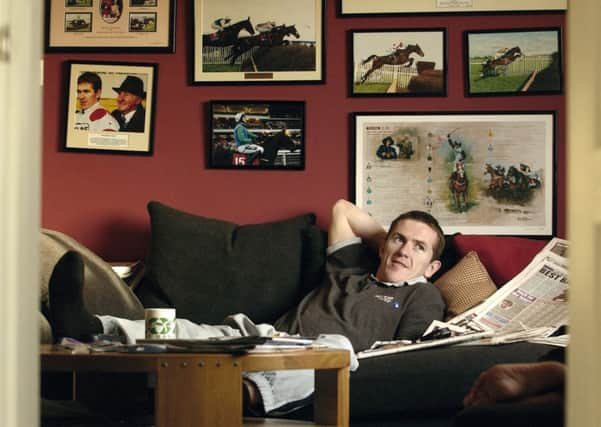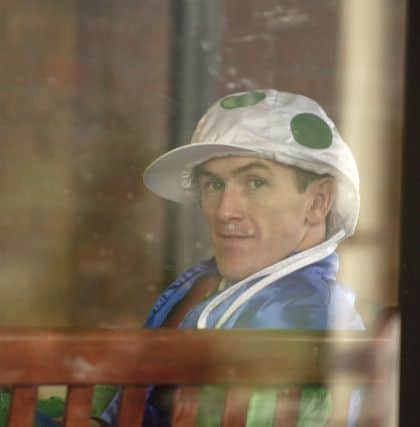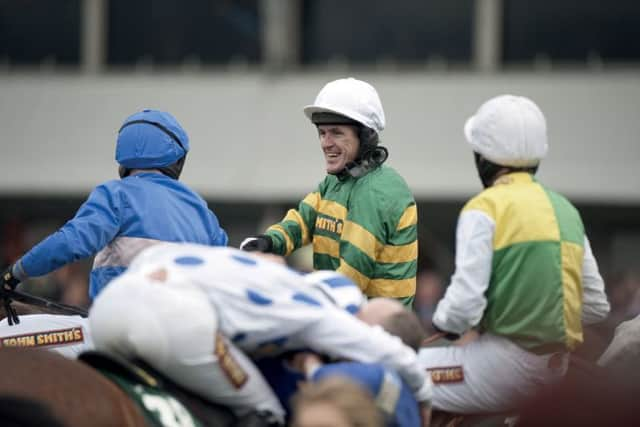Grit and glory in sharp focus


THE name AP McCoy barely registered with photographer Ed Whitaker when he was first asked to picture a young up-and-coming jump jockey 20 years ago.
“McCoy?” pondered Whitaker as he drove with little enthusiasm to Stratford racecourse to photo the 1994 champion conditional receiving his end-of-season trophy. This, it should be pointed out, was still the era of black and white photography and the job was so routine that the photographer and his subject did not even speak.
Advertisement
Hide AdAdvertisement
Hide AdHowever Whitaker did make a mental note to remember the name and to start paying more attention to the racing results in the morning paper.


“Someone on the picture desk obviously thought this rider was going to be a big deal. McCoy, I thought I better start following his career,” he told The Yorkshire Post.
“After three or four years, it was obvious we were in the presence of someone who was particularly special, and who would be taking the art of jockeyship into a different stratosphere.”
Little did Whitaker know that this young tyro, a quietly-spoken son of County Antrim, would become a sporting phenomenon who became the first jump jockey to ride 2,000, 3,000 and then 4,000 winners over obstacles.
Advertisement
Hide AdAdvertisement
Hide AdSuch prescience is rewarded with McCoy: In The Frame. A lovingly-produced coffee table book, it charts the record-breaking rider’s career in pictures – the wins, the falls and the tender moments as the 19-times champion jockey shares the agony and ecstasy of his unrivalled career with his wife Chanelle and the couple’s young children.


“He is very photogenic, he has the face of a fighter,” marvels Whitaker whose late father James was the longstanding royal correspondent of the Daily Mirror.
“He’s got a lot of character in his face. You look at him and think you could be photographing a boxer. That’s when he is battered and bruised.
“He is very chiselled with very strong features. He’s great to photograph in the finish of a race – he just grits his teeth.
Advertisement
Hide AdAdvertisement
Hide Ad“The two main jockeys in my life, and I have been at the Racing Post for 27 years since I started in 1987, are Frankie Dettori and Tony McCoy. I’ve photographed them more than anyone else.
“They are totally different characters, but it took McCoy much longer – possibly until the 2001-02 season when he broke the record of Sir Gordon Richards for most winners (269) in a single season. Now, in his early 40s, it’s not impossible for him to win 300 races this season.”
There is a pause as Whitaker reflects on his hero’s longevity – it is testament to McCoy that his career merits such a pictorial tribute – and belated recognition that horse racing’s patron saint of lost causes is belatedly being recognised as one of the all-time great achievers of world sport.
Whitaker was not among the racegoers in the drizzle at Wetherby on Wednesday last week to witness the extent to which McCoy puts his body on the line because his phenomenal psyche simply will not countenance defeat.
Advertisement
Hide AdAdvertisement
Hide AdHe limped out of the weighing room and grimaced with pain when legged up onto Goodwood Mirage – he had suffered a serious shoulder injury in a fall six days previously that would have left the most battle-hardened sporting warriors on the sidelines for weeks and, possibly, months.
McCoy did not have to be at his best, or strongest, to record his 150th winner of the season – albeit by a rapidly-diminishing neck – and hobbled back to the sanctuary of the weighing room where, in a rare concession on his part, he gave up his remaining rides on the afternoon.
McCoy’s mood looked black. He looked everyone of his 41 years and trainers and jockeys question the champion’s wisdom of defying so much pain when he has nothing left to prove – except to himself. Wearing just his breeches, the skeletal jockey could barely hold his left arm as talked to connections.
This was professional racing at its most raw and it is not surprising that Ed Whitaker’s most memorable photographs of AP McCoy are of the rider, unnaturally tall at 5ft 10ins for a professional sportsman who often races at a ridiculously light 10st 4lb, in the thick of the action.
Advertisement
Hide AdAdvertisement
Hide Ad“They are usually when he is splattered in mud, or when he is bruised and battered. You photo him looking badly injured – and then he’s back in the saddle. He is an amazing man. He is the toughest man I have come across,” he said.
McCoy is also one of the most accessible in an era when lower league footballers, cricketers and rugby players – competitors with no medals or trophies to their name – are cosseted and molly-coddled by agents and PR flunkies.
Take the time that the rider fractured his cheekbone and Whitaker asked whether he could picture the injury. Most would say no. Not McCoy who invited the photographer to his house andthen posed for a series of images that are amongst the most striking to be taken by the man behind the lens.
“It has a silhouette feel to it. He’s looking in the mirror in his bathroom and he is touching his face. It doesn’t say much, apart from the price he pays for every fall. I like the light and reflection. I never remember him saying no to a picture I suggested.”
Advertisement
Hide AdAdvertisement
Hide AdWhitaker was in tow when McCoy underwent Kriotherapy treatment in an ice chamber – McCoy withstood three minutes at a record low of minus 149C just to re-enforce his iron-will – in order to accelerate the recovery of a fractured vertebrae that he suffered following a fall at Warwick in January 2008, another example of the risks faced by jockeys.
It worked, though Whitaker declined the Kriotherapy experience so he could capture the jockey emerging from his torture chamber.
Two months later, McCoy galvanised a winning run out of Albertas Run at the blue riband Cheltenham Festival – jump racing’s Olympics.
Only sport’s Mr Indefatigable could have done this and been so open with the media about his determination.
Advertisement
Hide AdAdvertisement
Hide AdThe same probably doesn’t apply to the at times strained working relationship between Whitaker’s father and members of the Royal family who he chronicled for several decades, and in particular Prince Charles when the heir to the throne was searching for love, happiness – and a wife – in the 1970s.
It was his father’s working trip to the world-famous Badminton horse trials in Gloucestershire that led to Whitaker being drawn to a journalism career in photography rather than following in his famous father’s footsteps as a scribe.
“I liked to photograph the horses and the photographers were great. Tim Graham lent me a camera and I got a sequence of Princess Anne falling at the water jump,” Whitaker takes up the story.
“I made some money, £50, and I was always going to be a photographer from that moment onwards. I was brought up with the media – my brother is head of news at Hello magazine.”
Advertisement
Hide AdAdvertisement
Hide AdIt was the instinct of a journalist that led to Ed Whitaker being positioned just past the winning post for the 2010 John Smith’s Grand National.
Every racing photographer’s wish, he says, is to capture the moment of triumph and there were hopes that McCoy would finally prevail in the people’s race at the 15th attempt.
As well as the now iconic picture of McCoy waving his whip to the Aintree crowds after Don’t Push It pulled clear on the pulsating and punishing run-in, Whitaker’s book features shows the wide-smiled jockey, his goggles hanging around his neck, being congratulated by Paul Moloney who had finished third on State of Play.
Those who cover jump racing on a regular basis continue to be left in awe by the camaraderie exhibited by riders who are both friends and rivals.
Advertisement
Hide AdAdvertisement
Hide Ad“The jockeys are crazy... there is a great camaraderie amongst them. They are participating in one of the most dangerous sports of all and they look out for each other,” said Whitaker who had to be fleet-footed as photographers tried to secure the best shots as Don’t Push It made a triumphant return to the winner’s enclosure.
“That’s the one picture you want, the National winner crossing the line.
“It was the one race McCoy wanted to win and I would have hated to have been elsewhere.”
Understandably, In The Frame does full justice to the National. There’s also a range of pictures from the jockey looking moody and pensive as he stares out of the Cheltenham weighing room to the explosive shot of McCoy aboard the brilliant two-mile chaser Master Minded in the Tingle Creek Chase at Sandown and which illustrates the speed of a horse race.
Advertisement
Hide AdAdvertisement
Hide AdThis sport is not for the faint-hearted and AP McCoy continues to defy gravity.
Despite his recent injury setback, he is still on course to win a 20th successive jockeys’ title in addition to the title that he won as an emerging talent.
His like will never be seen again and he admitted last week that two things scare him in life – being second best and retirement.
“I guess the next big photograph will possibly be his 300th winner in a season if he does it by next April. It is still do-able, then his 5,000th career winner if he stays fit. It’s all numbers now,” adds Ed Whitaker.
Advertisement
Hide AdAdvertisement
Hide Ad“It’s very unlikely, as I don’t follow him day to day, that he might just call it quits without warning because he has had a bad fall.
“I hope not. It would be great to capture him on his last day of racing – and riding a winner.”
• McCoy: In The Frame is published by Racing Post Books, price £20.